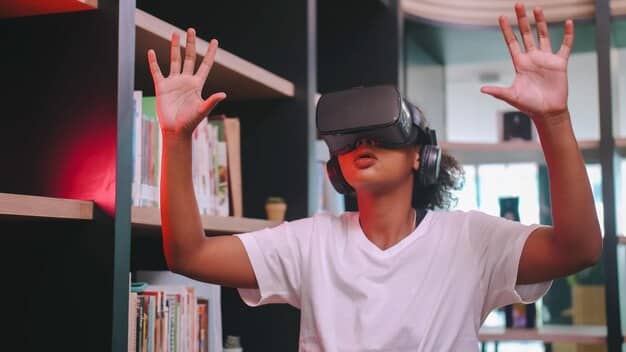Gen Z’s Learning Styles: 4 Innovative Approaches Reshaping Education in 2025

Gen Z’s distinct learning preferences necessitate innovative educational approaches, transitioning from passive instruction to immersive, personalized, and tech-integrated experiences for effective engagement in 2025.
The educational landscape is continuously evolving, shaped significantly by the distinct preferences of each new generation. As we approach 2025, understanding Gen Z’s Learning Styles: 4 Innovative Approaches Reshaping Education in 2025 becomes paramount. This demographic, born into a world saturated with digital connectivity, approaches knowledge acquisition with unique expectations that challenge traditional teaching methodologies. Their inherent digital fluency, desire for immediate feedback, and preference for visual and experiential content are not merely quirks, but fundamental characteristics that demand a recalibration of educational strategies. Embracing these styles is not just about keeping up with trends; it’s about fostering environments where Gen Z can truly thrive and prepare for a rapidly changing future.
Personalized Learning Paths: Tailoring Education to Individual Needs
Personalized learning is no longer a futuristic concept; it is a current necessity, especially when considering the diverse needs of Gen Z. This approach recognizes that each student is an individual with unique strengths, weaknesses, interests, and paces of learning. Moving beyond a one-size-fits-all curriculum, personalized learning seeks to create educational pathways that are as unique as the students themselves.
Adaptive Technologies and AI Integration
The backbone of personalized learning for Gen Z lies in advanced educational technologies. Adaptive learning platforms, powered by artificial intelligence, are capable of adjusting content difficulty and teaching methods in real-time based on a student’s performance and engagement. This means if a student masters a concept quickly, the system can provide more advanced material, or if they struggle, it can offer supplementary resources and different explanations.
- AI-driven assessment: Provides immediate, actionable feedback on student progress.
- Custom content curation: Recommends resources tailored to a student’s learning style.
- Pace flexibility: Allows students to move through topics at their optimal speed.
Student Agency and Choice
A critical component of personalized learning for Gen Z is fostering student agency. This generation values autonomy and the ability to contribute to their own learning journey. When students have a say in what they learn, how they learn it, and how they demonstrate their knowledge, their motivation and engagement skyrocket. This can manifest in project-based learning where students choose their topics, or in flexible lesson structures that allow for diverse approaches to problem-solving. It’s about shifting the focus from simply consuming information to actively constructing knowledge.
This approach often involves a mentor-like relationship between educators and students, where the teacher acts as a guide rather than just a dispenser of facts. They support students in setting their own goals, reflecting on their progress, and making informed decisions about their learning. It’s a dynamic and iterative process that responds to the evolving needs of each learner, promoting a deeper understanding and sustained interest in education.
Ultimately, personalized learning ensures that education resonates deeply with Gen Z, providing them with the tools and flexibility they need to navigate a complex world and empowering them to take ownership of their intellectual development. By embracing this tailored approach, educators can unlock the full potential of this digitally native generation.
Gamification and Immersive Experiences: Engaging the Digital Native
For Gen Z, learning is often most effective when it mirrors the interactive, immediate, and rewarding experiences they encounter in their digital lives. Gamification and immersive technologies, therefore, represent a powerful frontier in reshaping education by transforming passive learning into an active, engaging adventure. These approaches tap into Gen Z’s innate preference for interactivity and purpose-driven tasks.

Gamified Learning Platforms
Gamification integrates game-like elements into non-game contexts, such as education. This isn’t just about playing games in class; it’s about applying game design principles to learning activities. Elements like points, badges, leaderboards, and progress bars provide immediate feedback and foster a sense of achievement and healthy competition. Digital platforms are increasingly incorporating these mechanics, making complex subjects more digestible and entertaining.
- Instant feedback loops: Enables learners to understand mistakes and improve quickly.
- Progression and rewards: Motivates sustained effort and completion of tasks.
- Collaborative challenges: Encourages teamwork and problem-solving in a fun context.
Virtual and Augmented Reality (VR/AR)
Immersive experiences, particularly through VR and AR, offer unparalleled opportunities for experiential learning. Gen Z thrives on visual and hands-on engagement, and these technologies provide just that. Imagine dissecting a virtual frog without harming real animals, exploring ancient Rome from your classroom, or conducting complex chemistry experiments in a simulated lab. VR and AR can transport students to environments or scenarios that are otherwise inaccessible, providing context and depth that textbooks simply cannot match.
These technologies go beyond mere visualization; they offer interaction. Students can manipulate virtual objects, walk through historical sites, or even practice surgical procedures in a risk-free environment. This sensory-rich engagement enhances memory retention and makes abstract concepts tangible. The interactive nature of VR and AR aligns perfectly with Gen Z’s desire for active participation, making them not just observers, but active participants in their learning journey. The potential for these immersive experiences to revolutionize fields from medicine to art history is immense, offering a new dimension to how knowledge is acquired and retained.
By transforming education into an interactive, rewarding, and deeply immersive experience, gamification and VR/AR cater directly to the learning styles of Gen Z. These innovative approaches shift the paradigm from rote memorization to active exploration, fostering a generation of lifelong learners who are both engaged and highly skilled.
Project-Based Learning (PBL) and Real-World Application
Gen Z is inherently pragmatic and seeks relevance in their learning. Traditional, theoretical instruction often falls short of engaging them fully. Project-Based Learning (PBL) addresses this by centering education around comprehensive, real-world projects that require students to collaborate, problem-solve, and apply knowledge in meaningful contexts. This approach aligns with Gen Z’s desire to see the tangible impact and practical utility of their education.
Solving Authentic Problems
In PBL, students tackle authentic, complex questions or challenges that mirror real-world scenarios. Instead of simply memorizing facts, they engage in a deep inquiry process, developing solutions, and creating tangible products or presentations. For example, rather than learning about urban planning from a textbook, students might design a sustainable city model for their local community, researching zoning laws, environmental impacts, and economic factors.
- Interdisciplinary skills: Integrates knowledge from multiple subjects.
- Critical thinking: Encourages analysis, synthesis, and evaluation of information.
- Innovation and creativity: Fosters original solutions to complex problems.
Collaboration and Communication Skills
PBL inherently fosters collaboration, a crucial skill for the modern workforce. Students work in teams, assigning roles, sharing responsibilities, and communicating effectively to achieve a common goal. This mirrors the collaborative environments prevalent in workplaces and aligns with Gen Z’s preference for collective problem-solving. Furthermore, presenting their findings to an audience—whether peers, teachers, or community members—hones their communication and presentation skills, preparing them for professional interactions.
The emphasis on real-world application means that learning extends beyond the classroom walls. Students might interview local experts, conduct surveys, or visit relevant sites to gather data and insights. This connection to the wider community enhances the relevance of the project and provides students with valuable experience in navigating complex social and professional landscapes. PBL transforms learning from an abstract academic exercise into a dynamic, purposeful endeavor that directly prepares Gen Z for the challenges and opportunities of the future.
By engaging Gen Z in relevant, hands-world projects, PBL cultivates not only academic knowledge but also essential 21st-century skills like critical thinking, collaboration, and communication. This approach not only enhances engagement but also equips students to be proactive problem-solvers in an ever-evolving world.
Microlearning and On-Demand Content: Catering to Short Attention Spans
Gen Z has grown up with immediate access to information, often consumed in bite-sized pieces through social media feeds and short-form videos. This has fostered a preference for rapid, digestible content delivery. Microlearning and on-demand resources directly cater to this learning style by providing information in small, focused bursts, allowing students to access exactly what they need, precisely when they need it.

Bite-Sized Information Delivery
Microlearning breaks down complex topics into short, manageable modules, typically lasting a few minutes. Instead of lengthy lectures, students encounter concise videos, interactive infographics, quick quizzes, or short articles. This format is ideal for supplementary learning, quick refreshers, or addressing specific knowledge gaps without overwhelming the learner. It respects Gen Z’s often fragmented attention and busy schedules, allowing them to fit learning into short breaks or commutes.
- Increased retention: Easier to process and remember smaller chunks of information.
- Reduced cognitive load: Prevents information overload and frustration.
- Flexibility: Fits into diverse schedules and attention spans.
Just-in-Time Learning Resources
On-demand content takes microlearning a step further by making resources available precisely when a student encounters a need or a question. This is often facilitated through robust digital libraries, curated playlists, or dedicated online portals accessible anytime, anywhere. If a student is struggling with a particular mathematical concept while working on a problem, they can immediately pull up a short video explanation or an interactive tutorial on that specific topic, rather than waiting for the next class or office hours.
This “just-in-time” approach empowers students with agency over their learning. They are not beholden to a fixed curriculum pace but can proactively seek out information as their curiosity or academic challenges dictate. This fosters self-directed learning and problem-solving skills, which are invaluable in a world where information is constantly accessible. The ability to quickly find and consume relevant content reinforces learning and makes it a more intuitive and integrated part of daily life for Gen Z, bridging the gap between formal education and continuous self-improvement.
By embracing microlearning and on-demand content, educational institutions can align their delivery methods with Gen Z’s digital habits. This not only enhances engagement but also promotes self-sufficiency and the development of versatile learners capable of navigating a vast and ever-present digital information landscape.
Mental Health and Well-being Integration
While not a learning style in itself, the integration of mental health and well-being support is crucial for Gen Z’s overall learning effectiveness and academic success. This generation reports higher rates of anxiety and stress, often compounded by academic pressures and digital-era challenges. A holistic educational approach recognizes that a student’s mental state directly impacts their ability to learn, focus, and thrive.
Building Supportive Environments
Creating school environments that prioritize mental well-being means fostering open communication, reducing stigma around mental health issues, and providing accessible support services. This can include on-site counselors, peer support programs, and curriculum integration that teaches emotional literacy and coping mechanisms. It’s about building a culture where students feel safe to express their struggles and seek help without fear of judgment.
- Mindfulness practices: Regular short breaks or exercises to reduce stress.
- Flexible deadlines: Accommodations for challenging personal circumstances.
- Open dialogue: Encouraging students and staff to discuss mental health openly.
Holistic Development
An emphasis on holistic development means valuing emotional and social growth alongside academic achievement. This involves promoting healthy habits, such as adequate sleep, nutrition, and physical activity, which are fundamental to cognitive function and emotional resilience. Schools can integrate wellness programs, offer extracurricular activities that promote balance, and ensure that academic demands are balanced with opportunities for rest and leisure.
For Gen Z, who often navigate intense social pressures online and offline, feeling understood and supported emotionally is as important as receiving effective academic instruction. When their mental well-being is addressed, their capacity for learning, creativity, and engagement significantly increases. This focus on well-being prepares them not just for examinations, but for life beyond school, equipping them with resilience and self-care strategies necessary in a complex world. Educators are increasingly becoming aware that neglecting mental health is a barrier to genuine learning and overall development.
Integrating mental health and well-being support into educational frameworks is not an add-on, but a fundamental component of effective learning for Gen Z. By nurturing their emotional and psychological well-being, schools enable students to engage more fully with their education and develop into well-rounded, resilient individuals.
The Role of Educators in a Changing Landscape
As education evolves to meet Gen Z’s unique learning needs, the role of educators undergoes a significant transformation. No longer simply disseminators of information, teachers are becoming facilitators, mentors, and guides in a dynamic learning environment. Their adaptability and commitment to continuous professional development are paramount in shaping successful learning outcomes for this generation.
Facilitating Learner-Centered Environments
Educators must shift from traditional lecturing to creating learner-centered spaces where students are active participants in their education. This means designing engaging activities, fostering inquiry-based learning, and encouraging collaborative projects. The teacher’s role is to set the stage for learning, provide support, and guide students as they explore topics, rather than dictating every step. This involves a deep understanding of pedagogical approaches that empower students to take ownership of their learning journey.
- Curating resources: Identifying and leveraging diverse learning tools.
- Promoting autonomy: Empowering students to make choices in their learning.
- Encouraging critical thinking: Guiding students to question, analyze, and synthesize information.
Embracing Technology and Data
In a world rich with digital tools, educators must be proficient in leveraging technology to enhance learning. This includes utilizing adaptive learning platforms, integrating VR/AR experiences, and employing educational apps. Beyond simply using tools, teachers need to interpret data generated by these platforms to assess student progress, identify areas of difficulty, and personalize learning paths effectively. This data-driven approach allows for more precise interventions and tailored instruction.
Furthermore, effective educators for Gen Z are adept at fostering a growth mindset and building strong relationships with their students. They understand that psychological safety and a sense of belonging are crucial for engagement. This involves being empathetic, responsive to student feedback, and creating an inclusive classroom culture. The ability to connect with students on a personal level, understanding their motivations and challenges, allows teachers to provide more targeted support and inspire a genuine love for learning. Continuous professional development, focusing on new technologies, pedagogical strategies, and socio-emotional learning, is essential for educators to remain effective in this rapidly changing educational landscape.
The evolving role of educators is central to successfully implementing innovative learning approaches for Gen Z. By embracing new methodologies and adapting their practices, teachers can create engaging, effective, and supportive environments that prepare this generation for future success.
| Key Approach | Brief Description |
|---|---|
| 📊 Personalized Learning | Education tailored to individual student needs using adaptive tech. |
| 🎮 Gamification & Immersive Experiences | Using game elements and VR/AR for interactive, engaging learning. |
| 🛠️ Project-Based Learning | Solving real-world problems collaboratively to apply knowledge. |
| 📱 Microlearning & On-Demand Content | Bite-sized, accessible content for quick, flexible learning. |
Frequently Asked Questions About Gen Z Learning
A primary characteristic of Gen Z’s learning style is their inherent digital fluency and a strong preference for interactive, visual, and experiential content. They thrive in environments that offer immediate feedback and allow for personalized learning paths, often preferring to learn by doing and through problem-solving rather than passive reception of information.
Personalized learning benefits Gen Z by tailoring educational content and pace to their individual needs and interests. This approach, often supported by adaptive technologies, increases engagement, fosters autonomy, and ensures that each student can learn at their optimal speed, leading to deeper comprehension and retention of material. It addresses diverse learning profiles effectively.
Gamification and VR/AR are important for Gen Z education because they transform learning into an engaging, interactive, and immersive experience. These technologies align with Gen Z’s preference for digital interaction and immediate rewards, making complex subjects more accessible and stimulating. They promote active participation, problem-solving, and a deeper understanding through experiential learning.
The advantage of microlearning for Gen Z lies in its ability to deliver information in short, digestible segments, ideal for their typically shorter attention spans and busy schedules. This bite-sized content, such as quick videos or infographics, allows for flexible, on-demand learning, enabling students to access specific information precisely when needed, enhancing retention and self-directed learning.
Integrating mental health support profoundly impacts Gen Z’s learning by creating a supportive environment that reduces stress and anxiety. When students feel mentally well, their capacity for focus, engagement, and academic performance significantly improves. This holistic approach ensures that emotional and psychological well-being is considered a fundamental component of effective education, fostering resilience and overall student success.
Conclusion
The educational landscape is undergoing a profound transformation, driven by the unique characteristics and preferences of Gen Z. As we look towards 2025, it’s evident that traditional models are no longer sufficient to fully engage and equip this digitally native generation. By embracing personalized learning paths, integrating gamification and immersive technologies, prioritizing project-based learning with real-world applications, and adopting microlearning and on-demand content, educational institutions can create dynamic and effective environments. Moreover, recognizing and addressing mental well-being is not an ancillary concern but a fundamental component in fostering an atmosphere where Gen Z can truly thrive academically and personally. The role of educators in this evolving scenario becomes that of highly adaptable facilitators, leveraging technology and empathetic approaches to guide students. By continuously innovating and aligning instructional strategies with Gen Z’s inherent learning styles, we can ensure they are well-prepared to navigate a future that demands adaptability, critical thinking, and a lifelong commitment to learning.





